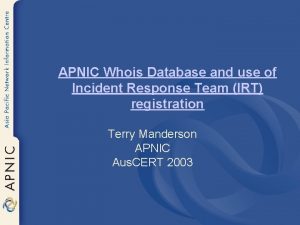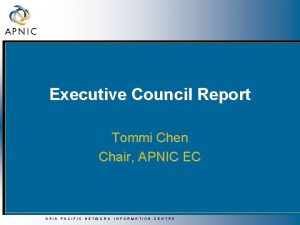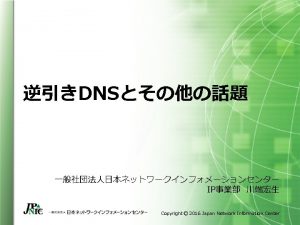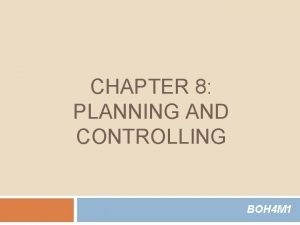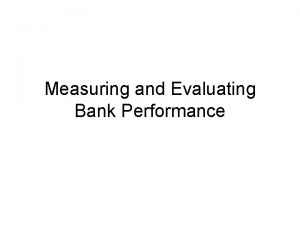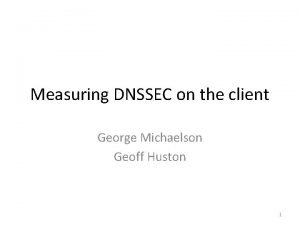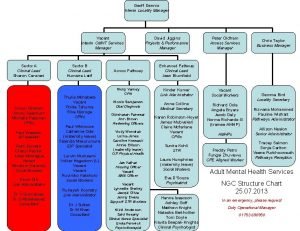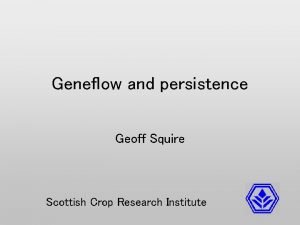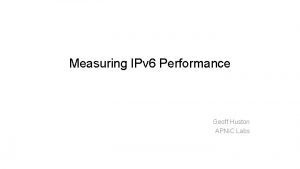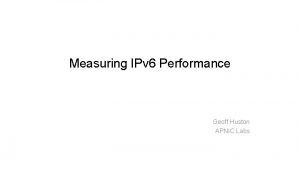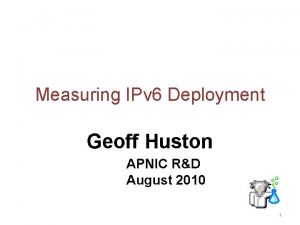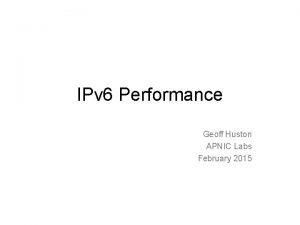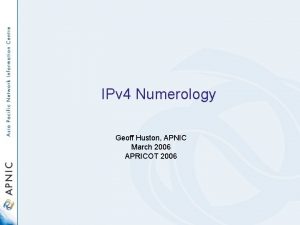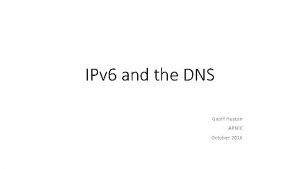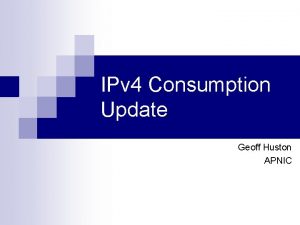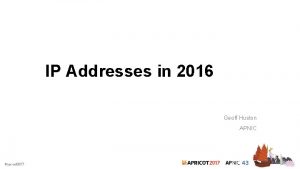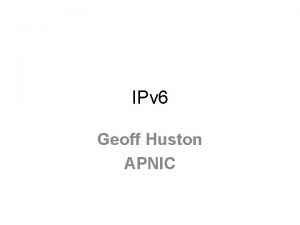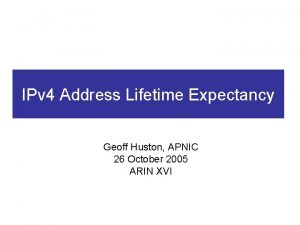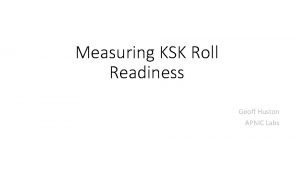Measuring IPv 6 ISP Performance Geoff Huston APNIC





































- Slides: 37

Measuring IPv 6 ISP Performance Geoff Huston APNIC Labs July 2016

What are we looking at: • How “reliable” are IPv 6 connections? d? e e c c u s ts p m e tt a n o ti c e n Do all TCP con • How “fast” are IPv 6 connections? ? 4 V n a th r e w lo s 6 Is V

What are we looking at: • How “reliable” are IPv 6 connections? d? e e c c u s ts p m e tt a n o ti c e n Do all TCP con • How “fast” are IPv 6 connections? ? 4 V n a th r e w lo s 6 Is V

Connection Failure Outbound SYN client server Busted SYN ACK Return path Outbound ACK an s i s see hing r e v tc er a s m e o CK n t th t A a u g h W N, b ncomin Y S i ing m o c in

Compare two data sets • The first data set has been collected across 2011 – Teredo and 6 to 4 were still active as IPv 6 mechanisms – Little in the way of other IPv 6 services • The second data set has been collected across 2015/2016

2011 - Measuring Failure

V 6 Failure Rate by Address Type Teredo All V 6 Average 6 to 4 Unicast

6 to 4 Failure is Local Failure 6 to 4 failure appears to be related to two factors: 1. The client’s site has a protocol 41 firewall filter rule for incoming traffic (this is possibly more prevalent in Asia. Pac than in Europe) 2. Load / delay / reliability issues in the server’s chosen outbound 6 to 4 relay (noted in the data gathered at the US server) Even so, the 10% to 20% connection failure rate for 6 to 4 is unacceptably high!

V 6 Unicast Failures January – March 2012: 110, 761 successful V 6 connecting endpoints 6, 227 failures That’s a failure rate of 5. 3%! 7 clients used fe 80: : link local addresses 7 clients used fc 00: /7 ULA source addresses 2 clients used fec 0: : /16 deprecated site local addresses 16 clients used 1 f 02: d 9 fc: : /16 Nobody used 3 ffe: : /16 prefixes!

Data Set 2: Connection Failure in 2015/2016 January 2015– January 2016 40, 359, 805 IPv 6 endpoints 1, 361, 256 Failure rate (3. 37%)

Daily IPv 6 Failures

Daily IPv 6 Failures RIP Flash! HTML 5 + TLS + Mobile Devices

6 to 4 7, 693, 849 6 to 4 endpoints l very This is stil high! – 19% of all IPv 6 used 6 to 4 – 9% failure rate within the set of 6 to 4 connections

Daily IPv 6 Failures

Daily IPv 6 Failures • 6 to 4 failure rate has improved from 15%-20% in 2011 to 9% in 2015 • Teredo has all but disappeared • Unicast failure rate is between 1. 5% and 4% in 2015 – Current unicast failure rate is 2%

Killing off 6 to 4 Proportion of IPv 6 connections using a 6 to 4 address

IPv 6 Failures – Sep 2015 – Jan 2016 20, 872, 173 unique IPv 6 Addresses 464, 344 failing IPv 6 addresses 142, 362 6 to 4 addresses 138 teredo addresses 68 fe 80: : local scope addresses 834 unallocated addresses 1, 244 unannounced addresses 319, 698 addresses from unicast allocated routed space 216, 620 unique /64 s

Origin AS’s with High IPv 6 Failure Rates

It’s not good! IPv 6 Unicast Failure rate: 1. 6% (falling) IPv 4 Failure rate: 0. 2% (steady)

What are we looking at: • How “reliable” are IPv 6 connections? d? e e c c u s ts p m e tt a n o ti c e n Do all TCP con • How “fast” are IPv 6 connections? Is V 6 slower than V 4?

Connection Failure Outbound SYN client server Return SYN+ACK Outbound ACK RTT Sample

Why SYN Handshakes? • Every TCP session starts with a SYN handshake • It’s typically a kernel level operation, which means that there is little in the way of transport protocol or application level interaction with the SYN exchange • On the downside there is only a single sample point per measurement

Generating a comparative RTT profile • For each successful connection couplet (IPv 4 and IPv 4) from the same endpoint, gather the pair of RTT measurements from the SYN-ACK exchanges • Use the server’s web logs to associate a couplet of IPv 4 and IPv 6 addresses • Use the packet dumps to collect RTT information from the SYN-ACK Exchange • Plot the difference in RTT in buckets

2012 Data

Number of samples (log scale) 2012 Data IPv 6 is faster 6 to 4 IPv 6 is slower Teredo Unicast RTT Difference (in fractions of a second)

Number of samples (log scale) December 2015/January 2016 IPv 6 is faster Unicast RTT Difference IPv 6 is slower

December 2015/January 2016 Number of samples (log scale) 6 to 4 IPv 6 is faster RTT Difference IPv 6 is slower

Number of samples (log scale) December 2015/January 2016 IPv 6 is faster RTT Difference IPv 6 is slower

2015/6 RTT Data CDF Proportion of samples IPv 6 is faster Unicast RTT Difference (millisecs) IPv 6 is slower 6 to 4

2015/6 RTT Data CDF Proportion of samples IPv 6 is faster IPv 6 is slower Unicast RTT Difference (milliseconds) 6 to 4

2015/6 RTT Data CDF Proportion of samples IPv 6 is faster IPv 6 is slower 32% of samples unicast IPv 6 is more than 10 msec slower than IPv 4 Unicast 13% of samples unicast IPv 6 is more than 10 msec faster than IPv 4 RTT Difference (milliseconds) 6 to 4 Zero point is 0. 44

Mapping the Data Convert the IPv 4/IPv 6 data points into Origin AS and Country Code RTT: Compute Relative RTT by simple subtraction (IPv 6 RTT – IPv 4 RTT) Compute the Mean and the Mean Standard Deviation Strip out data points > 1 MSTD from the Mean Add data to daily Country and Origin AS data sets Connection: Compute the ratio of failed IPv 6 to total seen IPv 6 Add data to daily Country and Origin AS data sets

The Connection Reliability Map This is a 30 day average value of V 6 systems. Units are % http: //stats. labs. apnic. net/v 6 perf

The Relative Performance Map IPv 6 – IPv 4 This is a 30 day average value of dual stack systems, comparing the V 6 RTT to the V 4 RTT by simple subtraction. Units are MS http: //stats. labs. apnic. net/v 6 perf

Country and per-AS reports http: //stats. labs. apnic. net/v 6 perf

Questions to you… • Is this helpful information? • Is the layout useful or not? • What other views would be helpful to you?

Thanks!
 Geoff huston apnic
Geoff huston apnic Isp
Isp Pure fabrication in grasp
Pure fabrication in grasp Ballad of booker t
Ballad of booker t Animal anthony apnic
Animal anthony apnic Debogon project
Debogon project Apnic whois
Apnic whois Myapnic
Myapnic Apnic ec
Apnic ec Apnic dns
Apnic dns Measuring the actual performance
Measuring the actual performance Measuring the actual performance
Measuring the actual performance Measuring computer performance
Measuring computer performance Types of plans in management
Types of plans in management 3 approaches to measuring performance
3 approaches to measuring performance John r. schermerhorn
John r. schermerhorn Approaches to measuring performance
Approaches to measuring performance Measuring and evaluating bank performance
Measuring and evaluating bank performance Occupancy percentage formula
Occupancy percentage formula Geoff michaelson
Geoff michaelson Geoff petty
Geoff petty Cdmhp
Cdmhp Lurvin munisami
Lurvin munisami Watchdog dad
Watchdog dad Geoff cundiff
Geoff cundiff Geoff hayward
Geoff hayward Geoff squire
Geoff squire Geoff barton dundee
Geoff barton dundee Geoff willis
Geoff willis Geoff knowles
Geoff knowles Geoff baines
Geoff baines Geoff layer
Geoff layer Icedip model of creativity
Icedip model of creativity Geoff buckley
Geoff buckley Geoff goldsmith
Geoff goldsmith Geoff savage
Geoff savage Geoff barton headteacher
Geoff barton headteacher Geoff kleinman
Geoff kleinman






